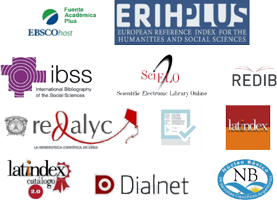¿Qué factores influyen en la construcción de ciudades inteligentes? Un modelo multinivel con datos a nivel ciudades y países
Palabras clave:
ciudades inteligentes, TIC, modelos de regresión multinivelResumen
En años recientes se ha dado importancia al concepto de “ciudades inteligentes” o smart cities. Se pueden distinguir dos visiones: la que se centra en el rol de las tecnologías de la información y de la comunicación (TIC); y la que se amplifica a nociones vinculadas con el crecimiento económico sostenible, la calidad de vida, la gobernanza participativa y la reducción de emisiones. Este trabajo tiene como objetivo contrastar estas visiones para analizar los factores que inciden en la construcción de ciudades inteligentes. Sobre la base de una muestra de 181 ciudades en 81 países, se estima un modelo de regresión multinivel, con datos a nivel ciudad y a nivel país. Los resultados obtenidos muestran que el modelo tiene un mejor ajuste en la primera visión: el nivel económico, el nivel educativo, la ubicación en América Latina y el hecho de ser ciudades de países desarrollados en TIC son factores que afectan positivamente el nivel de inteligencia de una ciudad. Por otro lado, el modelo expresado en un sentido amplio muestra que, cuanto menor es la tasa de desempleo urbana, mayor es el nivel de inteligencia de las ciudades.Descargas
Citas
ALBINO, V., UMBERTO, B. y DANGELICO, R. M. (2015): “Smart cities: definitions, dimensions, and performance”, Journal of Urban Technology, vol. 22, n° 1, pp. 3–21.
ANTHOPOULOS, L. y FITSILIS, P. (2010): “From Digital to Ubiquitous Cities: Defining a Common Architecture for Urban Development”, Proceedings of the 6th International Conference on Intelligent Environments IE10, Malasia, IEEE, pp. 301-306.
BELISSENT, J. y GIRON, F. (2013): Service Providers Accelerate Smart City Projects, Forrester Research Report, Cambridge, Forrester Publication.
CARAGLIU, A., DEL BO, C. y NIJKAMP, P. (2009): Smart Cities in Europe, 3rd Central European Conference in Regional Science, Košice, 7-9 de octubre.
CLAYTON, J. y MACDINALD, S. J. (2013): “The limits of technology”, Information, Communication & Technology, vol. 16, n° 6, pp. 945-966.
DEBNATH, A. K., CHIN, H., HAQUE, M. y YUEN, B. (2014): “A methodological framework for benchmarking smart transport cities”, Cities, vol. 37, pp. 47-56.
DE LA CRUZ, F. (2008): “Modelos Multinivel”, Revista Peruana de Epidemiologia, vol. 12, n° 3, pp. 1-8.
DIEZ ROUX, A. (2002): “A glossary for multilevel analysis”, Journal of Epidemiology and Community Health, n° 56, pp. 588-594.
FLORIDA, R. y MELLANDER, C. (2012): “The Rise of Skills: Human Capital, the Creative Class and Regional Development”, CESIS Electronic Working Paper Series, n° 266.
GIBSON, D. V., KOZMETSKY, G. y SMILOR, R. W. (1992): The technopolis phenomenon: Smart cities, fast systems, global networks, Lanham, Rowman & Littlefield Publishers.
GIFFFINGER, R., HAINDLMAIER, G. y KRAMAR, H. (2010): “The role of rankings in growing city competition”, Urban research & practice, vol 3, n°3, pp. 299-312.
GLAESER, E. L. y SAIZ, A. (2004): “The Rise of the Skilled City,” Brookings-Wharton Papers on Urban Affairs, pp. 47–94.
HOLLAND, R. (2008): “Will the real smart city please stand up?”, City: analysis of urban trends, culture, theory, policy, action, vol 12, n°3, pp. 303-320.
KITCHIN, R., LAURIAULT, T.P. y MCARDLE, G. (2015): “Knowing and governing cities through urban indicators, city benchmarking and real-time dashboards”, Regional Studies, Regional Science, vol. 2, n° 1, pp. 6-28.
LETAIFA, S. B. (2015): “How to strategize smart cities: reveleaing the SMART model”, Journal of business research, vol. 68, n° 7, pp. 1414-1419.
LUPIAÑEZ, F. y FAULÍ, C. (2017): “Ciudades Inteligentes: Evaluación social de proyectos de Smart Cities”, Centro de Estudios de telecomunicaciones de América Latina.
MARCEAU, J. (2008): “Introduction: Innovation in the city and innovative cities”, Innovation: Management, Policy & Practice, vol. 10, n° 2-3, pp. 136-145.
MORETTI, E. (2004): “Estimating the Social Return to Higher Education: Evidence from Longitudinal and Repeated Cross-Sectional Data,” Journal of Econometrics, vol. 121, pp. 175–212.
MUSTERD, S. y OSTENDORF, W. (2004): “Creative cultural knowledge cities: Perspectives and planning strategies”, Built Environment, vol. 30, n° 3, pp. 188–193.
NAM, T. y PARDO, T. A. (2011): “Smart city as urban innovation: focusing on management, policy and context”, ICEGOV2011, 26-28 de septiembre, Tallinn.
NEIROTTI, P., DE MARCO, A., CAGLIANO, A., MANGANO, G. y SCORRANO, F. (2014): “Current trends in smart city initiatives: some stylized facts”, Citie, vol. 38, pp. 25-36.
OCDE (2003): PISA 2003. Manual de análisis de datos, Madrid, OCDE.
ODENDAAL, N. (2003): “Information and communication technology and local governance: Understanding the difference between cities in developed and emerging economies”, Computers, Environment and Urban Systems, vol. 27, n° 6, pp. 585-607.
PARTRIDGE, H. L. (2004): “Developing a human perspective to the digital divide in the ‘smart city’”, en H. Partridge (ed.): Australian Library and Information Association Biennial Conference, 21-24 de septiembre, Gold Coast.
PASKALEVA, K. A. (2009): “Enabling the smart city: the progress of city e-governance in Europe”, Int. J. Innovation and Regional Development, vol. 1, n° 4, pp. 405–422.
RAUCH, J. E. (1993): “Productivity Gains from Geographic Concentration of Human Capital: Evidence from the Cities”, Journal of Urban Economics, vol. 34, pp. 380–400.
SHAPIRO, J. M. (2006): “Smart Cities: Quality of Life, Productivity, and the Growth Effects of Human Capital,” Review of Economics and Statistics, vol. 88, pp. 324–335.
STEINERT, K., MARON, R., RICHARD, P., VEIGA, G., y WITTERNS, L. (2011): “Making cities smart and sustainable. Global innovation index report”, pp. 87–95. Disponible en: https://www.globalinnovationindex.org/userfiles/file/GII-2011_Report.pdf.
TOPPETA, D. (2010): “The Smart City Vision: How Innovation and ICT Can Build Smart, ‘Livable’, Sustainable Cities”, The Innovation Knowledge Foundation.
WASHBURN, D., SINDHU, U., BALAOURAS, S., DINES, R. A., HAYES, N. M. y NELSON, L. E. (2010): “Helping CIOs understand ‘smart city’ initiatives: Defining the smart city, its drivers, and the role of the CIO”, Cambridge, Forrester Research, Inc. Disponible en: http://public.dhe.ibm.com/partnerworld/pub/smb/smarterplanet/forr_help_cios_und_smart_city_initiatives.pdf.
WEISI, F. y PING, P. (2014): “A discussion on smart city management based on meta-synthesis method”, Management Science and Engineering, vol. 8, n°1, pp. 68–72.
WEISS, M. et al. (2013): “Cidades inteligentes: casos e perspectivas para as cidades brasileiras”. Disponible en: http://www.altec2013.org/programme_pdf/1511.pdf
WINTERS, J. V. (2011): “Why are Smart cities growing: who moves and who stays”, Journal of Regional Science, vol. 51, n° 2, pp. 253-270.
ZYGIARIS, S. (2012): “Smart city reference model: Assisting planners to conceptualize the building of smart city innovation ecosystems”, Journal of the Knowledge Economy, vol. 4, n° 2, pp. 217–231.
Descargas
Publicado
Cómo citar
Número
Sección
Licencia
Todos los números de CTS y sus artículos individuales están bajo una licencia CC-BY.
Desde 2007, CTS proporciona un acceso libre, abierto y gratuito a todos sus contenidos, incluidos el archivo completo de su edición cuatrimestral y los diferentes productos presentados en su plataforma electrónica. Esta decisión se sustenta en la creencia de que ofrecer un acceso libre a los materiales publicados ayuda a un mayor y mejor intercambio del conocimiento.
A su vez, para el caso de su edición cuatrimestral, la revista permite a los repositorios institucionales y temáticos, así como también a las web personales, el auto-archivo de los artículos en su versión post-print o versión editorial, inmediatamente después de la publicación de la versión definitiva de cada número y bajo la condición de que se incorpore al auto-archivo un enlace a la fuente original.











